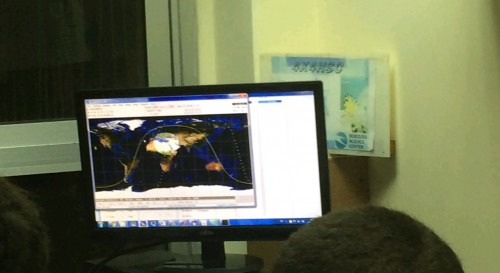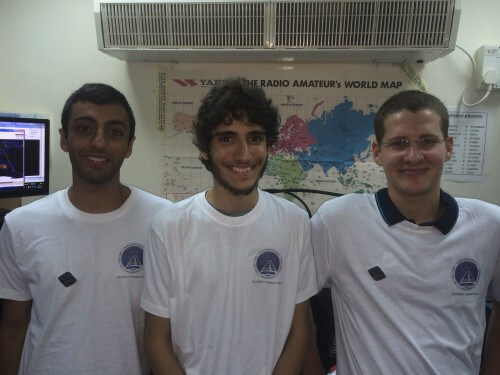Three recent graduates of the project brought up the contribution of Dr. Anna Heller, who initiated the construction of the students' satellite

"The first Israeli nano-satellite is working perfectly," said this evening Midad Farinta, Midad Farinta, CEO of the Specialist company - the system engineer of Dokifat 1, as soon as the first telemetry signals from the satellite arrived, around 23:55 p.m.
Farina and other experts from the Specialist company, the aerospace industry and of course from the science center itself taught the students the skills needed to build the satellite and accompanied the process until the successful launch.
In an interview with the Hidaan site during a special launch event held at the Science Center in Herzliya with the participation of students, parents, teachers, senior officials in the space industry, as well as the Mayor of Herzliya Moshe Padlon and the head of the space committee at the National Research and Development Council (NRC) Prof. Haim Ashad.
"All the indicators we received from the satellite during its first pass indicate normal activity, the solar panels, the antennas are deployed, we hear it loudly. The next step is In Orbit Testing. In the coming week we will perform tests to see that indeed all the systems are working as we expected, and if indeed these tests pass successfully, we will put it into operational activity both for rescue and rescue missions and as a relay station for amateur radio."
How exactly will it be possible to use the satellite for rescue and rescue?
"There is a need for a dedicated transmitter called (APRS (Automatic Packet Reporting System), which travelers buy before traveling to areas where there is no cellular coverage - jungles, forests, deserts. In a week when we become operational, anyone who wants to join the emergency and rescue network will know which frequency we work on which The type of messages we know how to receive, etc.
One of the guests at the launch event was Jonathan Weintraub, one of the three co-founders of the SpaceIL project and the technical lead of the project that plans to launch a spacecraft that will land on the moon as part of the Google Lunar X Prize competition and use this competition as a means of encouraging math and science studies. It turns out that in the many incarnations of the satellite that was launched tonight, Levintraub, now 27 years old, was also a part: "I was a student of Anna Heller when the program started, I was from the founding generation. The developments of the satellite included several generations. Initially I worked on the satellite's direction control and system engineering and several years ago I returned to teach here as an instructor so that I got to guide the next generations in all disciplines. I'm proud to see this program come to launch a little more than a decade after it started."
Why did it take so long?
These are high school students, a long effort over many years. I think this is an extraordinary achievement, one of the first high schools, the first in Israel and Europe to set up such a project, the first time is always more difficult and we hope that there will be a large number of satellites in the coming years."
"From the experience I had when I taught here, I see that it is much easier for students to connect with engineering and science when they have an understanding of what to do with it, that is, when there is something intuitive. A satellite can provide the concrete incentive. One of the students I had here studied four units of mathematics and did not intend to do a matriculation in physics and during the project he wanted to investigate a certain direction of the system, I explained to him that in order to progress in what he wanted he needed a physical understanding of the problem and a year later he enrolled in the matriculation with five units of mathematics and five units of physics and graduated Successfully. What he lacked was the understanding of what to do with it, and a project like this and projects like it and SpaceIL are great thanks to the incentive for children to go study scientific subjects which are more difficult subjects and less rewarding in the immediate term."
What is the status of the SpaceIL project?
The SPACEIL project is progressing according to plan. There is still a need to complete technical developments. Coming Soon.
The fresh graduates

In the audience there were also several who graduated last year, and three of them, who today contribute as part of a year of service, were interviewed by the Hidan website - Sagi Bakal, Nimrod Doron and Luka Selira, all three of them 19 years old.
Bakal: "I was among those responsible for the ground station. We built it from scratch. Our goal was to establish a ground station that would operate automatically, without human contact, that the antennas would automatically follow the satellite, radios would automatically receive the transmission from the satellite. As part of our studies, we took a course and received a radio amateur license so that we would be authorized by the Ministry of Communications to transmit and receive the satellite.
Nimrod Doron, also a member of the communications team: "I was the director of the ground station, and together we set up the station here with all the components from the antennas to the computers, some of the devices we built, some we bought."
Lucas Lira: "The most important thing we learned here is teamwork, this is in addition to the professional aspects such as radio amateurs, communication, radio waves, we learned about satellites. Because we started at a relatively young age - in the XNUMXth grade we learned about the universe, physics, the solar system, this put us in the mood. It was a good experience and we do not rule out the possibility of continuing in the future.
Sagi Doron would like to thank Anna Heller, who heads the project (and who stayed with some of the students at the launch site in Russia) without her guidance, without her help and support, the accompaniment, this whole project would not have come to fruition.
And adds Nimrod Bakal: "She said she caught us because we had a shine in our eyes, she had a greater shine."

4 תגובות
nachum is this supposed to be a joke?
I was given by the founders section. // In the beginning I worked// and such a project and such projects // so that you are qualified - typos